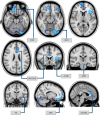Association of Clinical and Neuroanatomic Factors With Response to Ventral Tegmental Area DBS in Chronic Cluster Headache
- PMID: 37848331
- PMCID: PMC10752645
- DOI: 10.1212/WNL.0000000000207750
Association of Clinical and Neuroanatomic Factors With Response to Ventral Tegmental Area DBS in Chronic Cluster Headache
Abstract
Background and objectives: Deep brain stimulation (DBS) of the ventral tegmental area (VTA) is a surgical treatment option for selected patients with refractory chronic cluster headache (CCH). We aimed to identify clinical and structural neuroimaging factors associated with response to VTA DBS in CCH.
Methods: This prospective observational cohort study examines consecutive patients with refractory CCH treated with VTA DBS by a multidisciplinary team in a single tertiary neuroscience center as part of usual care. Headache diaries and validated questionnaires were completed at baseline and regular follow-up intervals. All patients underwent T1-weighted structural MRI before surgery. We compared clinical features using multivariable logistic regression and neuroanatomic differences using voxel-based morphometry (VBM) between responders and nonresponders.
Results: Over a 10-year period, 43 patients (mean age 53 years, SD 11.9), including 29 male patients, with a mean duration of CCH 12 years (SD 7.4), were treated and followed up for at least 1 year (mean follow-up duration 5.6 years). Overall, there was a statistically significant improvement in median attack frequency from 140 to 56 per month (Z = -4.95, p < 0.001), attack severity from 10/10 to 8/10 (Z = -4.83, p < 0.001), and duration from 110 to 60 minutes (Z = -3.48, p < 0.001). Twenty-nine (67.4%) patients experienced ≥50% improvement in attack frequency and were therefore classed as responders. There were no serious adverse events. The most common side effects were discomfort or pain around the battery site (7 patients) and transient diplopia and/or oscillopsia (6 patients). There were no differences in demographics, headache characteristics, or comorbidities between responders and nonresponders. VBM identified increased neural density in nonresponders in several brain regions, including the orbitofrontal cortex, anterior cingulate cortex, anterior insula, and amygdala, which were statistically significant (p < 0.001).
Discussion: VTA DBS showed no serious adverse events, and, although there was no placebo control, was effective in approximately two-thirds of patients at long-term follow-up. This study did not reveal any reliable clinical predictors of response. However, nonresponders had increased neural density in brain regions linked to processing of pain and autonomic function, both of which are prominent in the pathophysiology of CCH.
© 2023 American Academy of Neurology.
Conflict of interest statement
S. Cheema is supported by a research fellowship sponsored by Abbott; F. Ferreira reports no disclosures relevant to the manuscript; O. Parras reports no disclosures relevant to the manuscript; S. Lagrata has received payment for educational presentations and attending advisory board meetings from Allergan, Eli Lilly, Novartis, TEVA, and Lundbeck Ltd and has received payment for consultancy work from Salvia; S. Kamourieh reports no disclosures relevant to the manuscript; A. Pakzad reports no disclosures relevant to the manuscript; L. Zrinzo acts as a consultant for and has received payment for educational presentations from Medtronic & Boston Scientific; M. Matharu is chair of the medical advisory board of the CSF Leak Association; has served on advisory boards for Allergan, Autonomic Technologies Inc, Eli Lilly, Novartis, Pfizer, Salvia, and TEVA; has received payment for educational presentations from Allergan, electroCore, Eli Lilly, Novartis, and TEVA; has received grants from Abbott, Medtronic, and electroCore; and has a patent on system and method for diagnosing and treating headaches (WO2018051103A1, issued); H. Akram reports no disclosures relevant to the manuscript. Go to
Figures



References
-
- Headache Classification Committee of the International Headache Society. The international classification of headache disorders, 3rd edition. Cephalalgia. 2018;38(1):1-211. - PubMed
Publication types
MeSH terms
LinkOut - more resources
Full Text Sources
